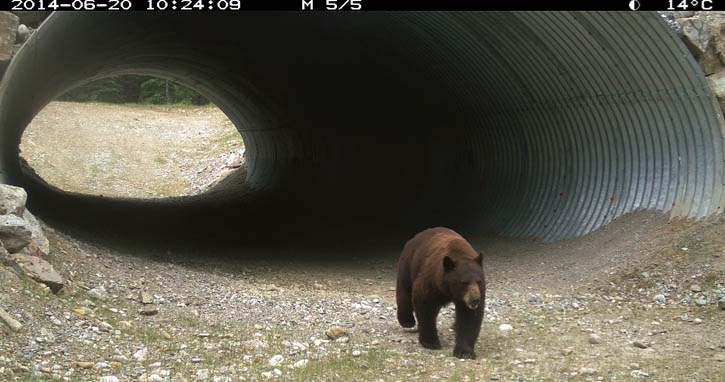A long-term study of the effectiveness of overpasses and underpasses in Banff National Park has shown 152,154 crossings by 11 different species of wildlife over a 17-year period.
Deer made up 48 per cent of all animal crossings from 1996-2014, while elk comprised 35 per cent of detected crossings. Large carnivores made up 13.5 per cent of use – coyotes, wolves, black bears, cougars and grizzly bears.
Only 10 wolverine and 18 lynx crossings were detected after 17 years of monitoring.
Scientist Tony Clevenger, who was the lead researcher on the project, said the data set is the world’s longest and most consistent effort to monitor wildlife use of highway crossing structures.
He said it took up to five years for some wary species, like grizzly bears, to start using wildlife crossing structures; however, most species are now using them to safely cross the highway.
“During the Banff-Bow Valley Study, there were people who came out publicly saying carnivores weren’t using the crossing structures,” said Clevenger, a research wildlife scientist with Western Transportation Institute at Montana State University.
“When we started monitoring, it became evident quickly that carnivores were actually using them, especially cougars and wolves.”
Wildlife use of crossing structures was presented in the Trans-Canada Highway Wildlife Monitoring and Research final report prepared by the Western Transportation Institute and Miistakis Institute for Parks Canada.
The Trans-Canada Highway has long been recognized as a deadly barrier to wildlife. Mitigation efforts over the past 30 years have helped restore habitat connectivity across large sections of this transportation corridor in Banff.
Animals need to cross the highway to search out companionship, mates, food, shelter and, in some cases, to escape predators. Since fencing and crossing structures were first constructed, wildlife-vehicle collisions have dropped by more than 80 per cent.
The highway cutting through Banff National Park has six overpasses and 38 underpasses between the park’s east gate and the B.C-Alberta border – the most wildlife crossing structures for any single stretch of highway anywhere in the world.
From 1996-2014, different methods were used to monitor wildlife, including track pads and cameras.
In addition, DNA research was undertaken to identify individual bears using the crossings. Barbed wire was strung across the wildlife structures to snag animal hair, then used to distinctly identify individuals.
“People were saying it’s probably just the same male grizzly going back and forth, but the DNA work showed that that was not the case,” Clevenger said.
From 1996 to 2014, there were 1,663 black bear crossings, 1,549 grizzly bear crossings, 1,627 cougar crossings, 8,749 coyote crossings, and 6,826 wolf crossings.
Grizzly bears used the Phase 3B crossings – the section from Castle Mountain to the B.C. border – comparatively more often than on other phases and appeared to have adapted to them sooner than the phase 3A crossings.
Nearly two-thirds of all wildlife crossings occurred in phase 1 and 2 – from the east gate of Banff National Park to the Sunshine interchange.
“This is largely due to the longer monitoring time period, and more abundant wildlife populations year-round in the lower areas of the Bow Valley,” Clevenger said.




